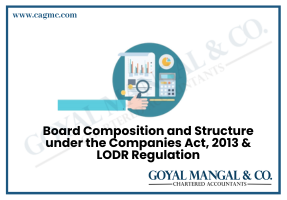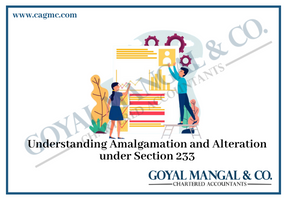| Table of Content |
The Companies majorly adopt the Reduction of share capital for their internal restructuring or for altering their capital structure which it involves reduction of issued, subscribed and paid up share capital of the Company whether pertaining to equity shares or preference shares or both of a Company.

Circumstances where Companies opt for reduction in their Capital:-
- Capital reduction with payout;
- Capital reduction without payout; and
- Selective capital reduction for a certain class of shares, with or without payout.
Various Aims/ objectives for reduction of capital which are as follows:-
- There are accumulated losses in the books of the Company which are currently being funded by its share capital and/or share premium and to the effect of same the balance sheet is “blown up” due to which a large share capital/premium is reflected on the liability side and accumulated losses on the asset side and setting off of the such accumulated losses against share capital/reserves leads to “resizing” the balance sheet.
- Relinquishment of the rights by some of the section of shareholders for the interest of the Company for which their Capital demands cancellation, this scenario is mostly seen during the case of a family settlement where some of the family members relinquish their own rights. This could be done with or without a payout.
- Sometimes a company may have excess surplus funds and which it may want to refund by reducing the share capital by any of the following way:
- either by reducing the face value or
- by cancelling some shares.
Provisions as per Corporate Law
The provisions pertaining to reduction of Capital are covered under Section 66 of the Companies Act, 2013 (other applicable provisions) and National Company Law Tribunal (Procedure for Reduction of Share Capital of Company) Rules, 2016.
As per Section 66 of the Companies Act, 2013 as defined below:-
A Company whether limited by shares or limited by guarantee and having a share capital by way of passing a Special Resolution and with the prior approval by the Tribunal on an application may reduce the share capital in any manner and in, particular, may—
- extinguish or reduce the liability on any of its shares in respect of the share capital not paid- up; or
- either with or without extinguishing or reducing liability on any of its shares,—
- cancel any paid-up share capital which is lost or is unrepresented by available assets; or
- pay off any paid-up share capital which is in excess of the wants of the company,
alter its memorandum by reducing the amount of its share capital and of its shares accordingly;
Note: A Company cannot reduce its Capital if the company is in arrears in the repayment of any of its deposits accepted by it, either before or after the commencement of this Act, or the interest payable thereon.
-
- A Notice of every application is to be given by the Tribunal made to it under sub-section (1) to the Central Government, Registrar and to the Securities and Exchange Board of India (in the case of listed companies), and also to the creditors of the company and shall consider the representations, if any, made to it by that Government, Registrar, the Securities and Exchange Board and the creditors within a period of 3 months from the date of receipt of the notice:
If the Tribunal does not receives any representation from the Central Government, Registrar, the Securities and Exchange Board of India or the creditors within the prescribed period, it shall be presumed that they do not have any objection to the reduction. - Upon satisfaction of the Tribunal pertaining to the discharge of debt or claim of every creditor of the has been determined or has been secured or his consent is obtained, make an order confirming the reduction of share capital on such terms and conditions as it deems fit.
Note: The Tribunal shall not sanction any application unless the accounting treatment proposed by the company for such reduction in share capital is in conformity with the accounting standards specified in section 133 or any other provision of this Act and a certificate to that effect by the company’s auditor has been filed with the Tribunal. - Once the Company receives order of confirmation for reduction of share capital by the Tribunal under sub- section (3) the same shall be published by the company in such manner as the Tribunal may direct.
- The certified copy of the order of the Tribunal shall be delivered by the Company along with the minutes approved by the Tribunal showing—
– the amount of share capital;
– the number of shares into which it is to be divided;
– the amount of each share; and
– the amount, if any, at the date of registration deemed to be paid-up on each share, to the Registrar within 30 days from the receipt of the copy of the order, who shall register the same and issue a certificate to that effect. - The certified copy of the order of the Tribunal shall be delivered by the Company along with the minutes approved by the Tribunal showing—
- the amount of share capital;
- the number of shares into which it is to be divided;
- the amount of each share; and
- the amount, if any, at the date of registration deemed to be paid-up on each share, to the Registrar within 30 days from the receipt of the copy of the order, who shall register the same and issue a certificate to that effect.
- As per sub section (6) this section shall not apply to buy-back of its own securities by a company under section 68.
- A member of the company, past or present, shall not be liable to any call or contribution in respect of any share held by him exceeding the amount of difference, if any, between the amount paid on the share, or reduced amount, if any, which is to be deemed to have been paid thereon, as the case may be, and the amount of the share as fixed by the order of reduction.
- Where the name of any creditor entitled to object to the reduction of share capital under this section is, by reason of his ignorance of the proceedings for reduction or of their nature and effect with respect to his debt or claim, not entered on the list of creditors, and after such reduction, the company commits a default, within the meaning of section 6 of the Insolvency and Bankruptcy Code, 2016, in respect of the amount of his debt or claim.
- Every person, who was a member of the company on the date of the registration of the order for reduction by the Registrar, shall be liable to contribute to the payment of that debt or claim, an amount not exceeding the amount which he would have been liable to contribute if the company had commenced winding up on the day immediately before the said date; and
- if the company is wound up, the Tribunal may, on the application of any such creditor and proof of his ignorance as aforesaid, if it thinks fit, settle a list of persons so liable to contribute, and make and enforce calls and orders on the contributories settled on the list, as if they were ordinary contributories in a winding up.
- Nothing in sub-section (8) shall affect the rights of the contributories among themselves.
- If any officer of the company—
- knowingly conceals the name of any creditor entitled to object to the reduction;
- knowingly misrepresents the nature or amount of the debt or claim of any creditor; or
- abets or is privy to any such concealment or misrepresentation as aforesaid, he shall be liable under section 447.
- If a company fails to comply with the provisions of sub-section (4), it shall be punishable with fine which shall not be less than five lakh rupees but which may extend to twenty-five lakh rupees.
- A Notice of every application is to be given by the Tribunal made to it under sub-section (1) to the Central Government, Registrar and to the Securities and Exchange Board of India (in the case of listed companies), and also to the creditors of the company and shall consider the representations, if any, made to it by that Government, Registrar, the Securities and Exchange Board and the creditors within a period of 3 months from the date of receipt of the notice:
Modes of Reduction
As per the section 66 of the Companies Act, 2013 a company limited by shares or limited by guarantee and having a share capital may, by a special resolution, reduce its share capital in the following manner–
- Extinguish or reduce the liability on any of its shares in respect of the share capital not paid-up; or
Example- if the shares are of face value of Rs. 50 each of which Rs. 25 has been paid, the company may reduce them to Rs. 25 fully paid-up shares and thus relieve the shareholders from liability on the uncalled capital of Rs. 25 per share. - Either with or without extinguishing or reducing liability on any of its shares,
- cancelling any paid-up share capital which is lost or is unrepresented by available assets; or Example- if the shares of face value of Rs. 50 each fully paid-up is represented by Rs. 25 worth of assets. In such a case, reduction of share capital may be effected by cancelling Rs. 25 per share and writing off similar amount of assets.
- paying off any paid-up share capital which is in excess of the wants of the company,
Example- shares of face value of Rs. 50 each fully paid-up can be reduced to face value of Rs. 25 each by paying back Rs. 25 per share.
Benefits of Reduction of Share Capital
- The Reduction of Share Capital would cause the Balance Sheet to bring in true and fair representation of the Company by the available assets of the Company and reflect the real financial position of the Company.
- The financial restructuring will help the Company to reflect the true shareholder value which would place the Company in a position to pay dividend or raise capital in future.
Procedure for Capital Reduction
The procedure for reduction of share capital under section 66 of the companies act, 2013 read with NCLT (Procedure for Reduction of Share Capital) Rules, 2016 is tabled under:-
| S. No. | Particulars | Form No. | Time Period |
| 1. | Check whether the Company is authorized by its Articles of Association to reduce the share capital. | — | — |
| 2. | Issue Notice to hold Board of Directors Meeting to approve the Scheme of Reduction of Capital. | — | 7 days |
| 3. | Convene and hold a BM for the following purpose-
|
— | — |
| 4. | Issue Notice and hold the EGM of the Members. | — | 21 Clear Days |
| 5. | Hold EGM and pass Special Resolution for Reduction of Share Capital. | — | — |
| 6. | Company has to file the copy of SR and Explanatory Statement with the ROC. | MGT-14 | Within 30 days from the date of passing the SR |
| 7. | Prepare a List of Creditors, which should be class- wise, indicating their names, addresses and amounts owed to them. | — | Not earlier than 15 days prior to making of Application to Tribunal |
| 8. | Filing of Application with the NCLT to approve the Reduction of Share Capital along with the prescribed fee of Rs. 5000 | RSC-1 | — |
| 9. | Application shall be filed along with the following documents:
|
— | — |
| 10. | The Tribunal shall give notice or direct the Company that notice be given to-
|
RSC-2 RSC-2 RSC-3 |
Within 15 days from the Submission of Application |
| 11. | The respective notices to the Central Government, ROC and each Creditor should be sent along with the Scheme of Reduction of Capital. | — | Within 7 days of direction given by Tribunal |
| 12. | The Tribunal shall also give directions for the Notice to be published in one leading English Newspaper and one leading Vernacular language Newspaper and for uploading on the website of the company (if any). | RSC-4 | Within 7 days of direction was given by the Tribunal |
| 13. | The company or the person who was directed to issue notices and the publication in newspaper shall file an affidavit confirming the dispatch and publication of the notice. | RSC-5 | Within 7 days from the date of issue of the Notice |
| 14. | If the Tribunal is satisfied that the debt or claim of every creditor has been discharged or determined or has been secured or his consent is obtained, it may dispense with the requirement of giving of notice to creditors or publication of notice or both. | — | — |
| 15. | Representation by ROC, SEBI and Creditors shall be sent to the Tribunal and copy of which shall also be sent to the company. If no such representation has been received by Tribunal within the said period, it shall be presumed that they have no objection. | — | within 3 months of receipt of notice |
| 16. | Company shall send the representation or objections so received to the Tribunal along with responses of the company thereto. | — | Within 7 days of expiry of period up to which the objections were sought |
| 17. | The Tribunal may give such directions as it may think fit with respect to holding of any enquiry or adjudication of claims or for hearing the objection or otherwise. | — | — |
| 18. | If the Tribunal is satisfied with the process of Reduction of Share Capital, it may pass an order confirming the Reduction of Share Capital and approving the minute. | RSC-6 | — |
| 19. | The company shall file with the ROC a certified copy of the order approving the Scheme of Reduction of Share Capital and of minute by the Tribunal. | INC-28 | Within 30 days from the date of the receipt of order copy |
| 20. | The ROC shall issue a certificate under section 66(5) of the Companies Act, 2013 confirming the reduction of share capital. | RSC-7 | — |
Checklist of Document Required
The checklist of documents required for filing of application with the jurisdictional Hon’ble National Company Law Tribunal to approve the Reduction of Share Capital is tabled under:-
| S.No | Particulars |
| 1. | The list of Creditors duly certified by the Managing Director or in his absence by two Directors, as true and correct, which is made on a date not earlier than fifteen days prior to the date of filing of an application. |
| 2. | Certificate from the Auditor of the Company to the effect that the List of Creditor is correct. |
| 3. | Certificate by the auditor and declaration by the director of the company that the company is not in arrears in the repayment of the deposits or the interest thereon. |
| 4. | Certificate by the Auditor of the Company that the Accounting Treatment proposed by the Company for the Reduction of Share Capital is in conformity with the Accounting Standards specified in section 133 of the Companies Act, 2013. |
| 5. | Memorandum and Articles of Association of the company. |
| 6. | Notice of the general meeting together with the explanatory statement annexed to the notice, at which the special resolution has been passed. |
| 7. | Copy of the special resolution authorizing the reduction of share capital. |
| 8. | Copy of the latest audited balance sheet and profit and loss account of the company. |
| 9. | Minutes of proceedings at the general meeting at which the special resolution for reduction of share capital was passed. |
Kindly note that in case of listed company, the Company also need to comply regulations specified by the Securities and Exchange Board of India (‘SEBI’) .







